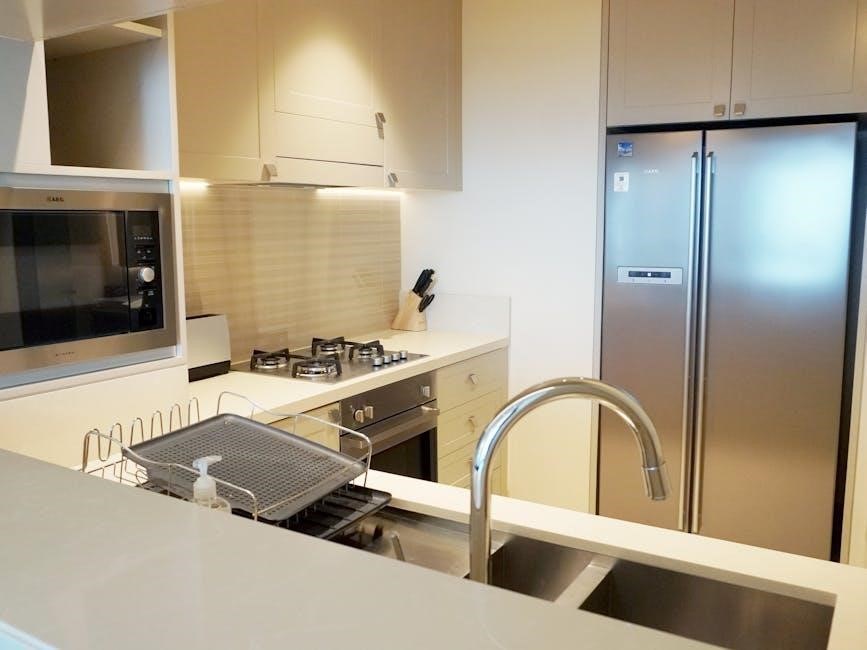The MagicTeam White Noise Machine is a versatile device designed to enhance relaxation and sleep quality with 40 soothing sounds, adjustable volume, and a memory function for personalized use.
Overview and Key Features
The MagicTeam White Noise Machine offers a wide range of features to enhance relaxation and sleep. It includes 40 non-looping sounds, such as white noise, lullabies, and nature sounds like rain and ocean waves. The device is compact and portable, making it ideal for travel. It features a memory function that automatically restores your last settings, including volume, sound, and timer. With 32 levels of volume control, you can customize the sound to your preference. The machine supports both AC and USB power options, providing flexibility for home or on-the-go use. Its user-friendly interface and timer settings allow for convenient operation.
Importance of the User Manual
The user manual is essential for understanding and utilizing the MagicTeam White Noise Machine effectively. It provides detailed instructions on setup, operation, and maintenance, ensuring optimal performance. The manual explains how to navigate features like volume control, timer settings, and the memory function; By following the guidelines, users can troubleshoot common issues and extend the device’s lifespan. Referencing the manual helps users maximize the machine’s benefits, such as improving sleep quality and creating a soothing environment. It serves as a comprehensive guide to unlocking all the machine’s capabilities and features.
Unboxing and Initial Setup
Start by carefully unpacking the MagicTeam White Noise Machine and its accessories. Plug in the power adapter, press the power button, and follow the on-screen instructions to begin setup.
What’s Included in the Package
The package includes the MagicTeam White Noise Machine, a user manual, an AC power adapter, a USB cable for portability, and occasionally a remote control for convenience. These accessories ensure easy setup and operation, allowing you to start enjoying the device immediately. The manual provides detailed instructions, while the adapters offer flexible power options. Everything you need for optimal performance is included, making the unboxing experience straightforward and user-friendly;
Step-by-Step Setup Instructions
First, unpack the device and ensure all components are included. Plug in the machine using the AC power adapter or connect it via USB for portability. Press the power button to turn it on. Use the volume control buttons to adjust the sound level to your preference. Select a desired sound using the navigation buttons. If needed, set the timer by pressing the timer button and choosing the duration. Familiarize yourself with the memory function, which recalls your last settings. Review the manual for additional features and troubleshooting tips to ensure optimal use.

Operating the MagicTeam White Noise Machine
Effortlessly navigate through the machine’s 40 soothing sounds, set timers, and adjust volume levels using the intuitive controls, ensuring a seamless and personalized experience for relaxation.
Choosing and Playing Different Sounds
The MagicTeam White Noise Machine offers a diverse library of 40 non-looping sounds, including white noise, lullabies, and nature sounds like rain and ocean waves. Users can easily navigate through the options using the designated sound selection buttons. Simply press the corresponding button to play the desired sound. The machine features a smooth transition between sounds, ensuring a continuous and immersive experience. This variety allows you to create a comforting environment tailored to your preferences, whether for sleep, relaxation, or concentration.
Setting the Timer for Customized Use
The MagicTeam White Noise Machine features a user-friendly timer, allowing you to customize the duration of sound playback. The available timer options include 1 hour, 2 hours, 3 hours, and continuous play, providing flexibility for different needs. To set the timer, simply press the corresponding timer button on the device. The machine will automatically turn off after the selected duration, ensuring uninterrupted sleep or relaxation. Additionally, the memory function saves your timer preferences, making it convenient to use the machine consistently without repeated adjustments. This feature enhances the overall user experience by simplifying operation.

Adjusting the Volume
The MagicTeam White Noise Machine allows easy volume adjustment using the + and ― buttons. Press + to increase and ⸺ to decrease the sound level, with 32 levels available for a personalized experience. The memory function saves your preferred volume setting for convenience.
Locating the Volume Control Buttons
The volume control buttons are conveniently placed on the front panel of the MagicTeam White Noise Machine. The “+” button increases the volume, while the “-” button decreases it. These buttons are intuitively designed for easy access, ensuring seamless adjustment of sound levels to suit your environment. Their straightforward placement allows users to quickly find and adjust the volume without needing to refer to the manual, enhancing the overall user experience and convenience.
Increasing and Decreasing the Volume
To adjust the volume on the MagicTeam White Noise Machine, locate the “+” button to increase the sound level and the “-” button to decrease it. Press and hold the buttons for continuous adjustment or press them briefly for incremental changes. The machine provides audible feedback, ensuring you can easily find your preferred volume. This intuitive design allows for smooth, precise control, enabling you to customize the sound to suit your environment perfectly.

Powering the Machine
The MagicTeam White Noise Machine can be powered using the included AC adapter for home use or via USB for convenient portability. Ensure the device is properly connected to a power source before operation.
Using the AC Power Adapter
The MagicTeam White Noise Machine comes with an AC power adapter for reliable home use. To use it, plug the adapter into a nearby electrical outlet, ensuring it’s firmly connected to both the machine and the wall. The device will automatically power on once connected. For safety, avoid using damaged cords or outlets. Always unplug the adapter when not in use or during cleaning to prevent any electrical issues. This ensures optimal performance and longevity of the machine.
USB Power Option for Portability
The MagicTeam White Noise Machine offers a convenient USB power option, enhancing its portability for travel or outdoor use. Simply connect the device to a compatible USB port using the provided cable. This feature is ideal for powering the machine without an AC outlet, making it perfect for trips or moving between rooms. Ensure your USB source is compatible and provides sufficient power for smooth operation. This flexibility allows you to enjoy your preferred sounds anywhere, maintaining a consistent sleep environment regardless of location.

Memory Function and Timer Settings
The MagicTeam White Noise Machine features a memory function that recalls your last settings and a timer with options for 1, 2, or 3 hours of continuous play.
Understanding the Memory Function
The memory function on the MagicTeam White Noise Machine automatically saves your last used settings, including chosen sound, volume level, and timer duration. This feature ensures a seamless experience by restoring these preferences upon turning the machine back on. It eliminates the need to readjust settings each time, making it convenient for daily use. The memory function is particularly useful for maintaining consistency in sleep routines, providing a hassle-free operation tailored to your preferences. This intelligent technology enhances user experience by saving time and effort, ensuring your settings are always remembered.
Using the Timer for Convenience
The timer function on the MagicTeam White Noise Machine allows you to set the device to operate for 1, 2, or 3 hours, or continuously. This feature is designed to enhance convenience, enabling you to customize the machine’s operation to suit your needs. By setting a timer, you can enjoy uninterrupted sound without manually turning it off, making it ideal for sleep or relaxation sessions. The timer ensures the machine shuts off automatically, saving energy and providing a seamless user experience tailored to your preferences. This feature is particularly useful for creating a consistent sleep routine.
Maintenance and Troubleshooting
Regularly clean the machine with a soft cloth and avoid moisture exposure to maintain performance. Troubleshoot issues by restarting or checking power connections for optimal functionality.
Cleaning and Caring for the Machine
To maintain your MagicTeam White Noise Machine, use a soft, dry cloth to wipe the exterior regularly. Avoid harsh chemicals or moisture, as they may damage the device. Gently clean the speaker grille with a dry cloth to ensure optimal sound quality. Keep the machine away from direct sunlight and store it in a cool, dry place when not in use. Regular cleaning helps preserve its performance and longevity, ensuring it continues to provide soothing sounds effectively.
Resolving Common Issues
If the machine fails to turn on, ensure it is properly plugged in and the power button is pressed firmly. For distorted sound, adjust the volume to a lower setting or check for obstructions near the speaker; If buttons are unresponsive, restart the device by unplugging and replugging it. To resolve looping sounds, reset the machine or update to the latest firmware. Regularly cleaning the speaker grille can also improve sound quality. Refer to the troubleshooting section in the manual for detailed solutions to these and other common issues.












































